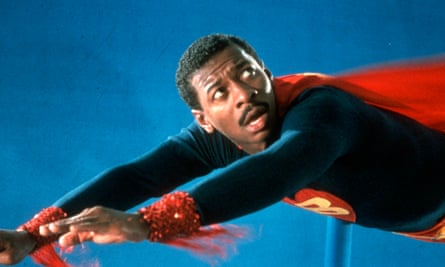Robert Townsend on making biting satire Hollywood Shuffle: ‘It was hard back
Robert Townsend moved to Los Angeles in the early 80s, determined to become a Hollywood star. And though he had quickly emerged as a draw on the standup circuit, the Chicago native struggled to reckon with the structural racism he encountered while auditioning for bit parts on film and TV – the vast majority of them ham-fisted stereotypes, from snitch to slave.
Before long, Townsend’s casting call stories – some of them humiliating, most of them hilariously tone deaf – became too overwhelming for his regular postmortems with Keenen Ivory Wayans, who was going through the exact same thing.
Even as he landed meaty supporting roles in Cooley High and A Soldier’s Story, Townsend tried roping Wayans into a film project about their career heartbreaks, but Wayans was skeptical. Townsend never went to film school, much less had shot or written anything. Townsend didn’t have much money either. What he did have was training with a Chicago theater group called the Experimental Black Actors Guild, starting at age 14. “I was around technicians who were Black – writers, directors, producers, set designers,” Townsend says to the Guardian. “I was telling Keenen, We can do this. There’s nothing mystical or magical about it.”
In 1987, a year after Spike Lee announced himself with She’s Gotta Have It, Townsend released Hollywood Shuffle – a 78-minute comedic allegory about the compromises the industry forces on Black actors in exchange for honest work. Townsend shows impressive range as hero Bobby Taylor, a hungry young actor who daydreams of roles in slave dramas and blaxploitation flicks – at once parodying familiar tropes while yearning to play them seriously. His off-screen hustle left a mark, too.
Townsend maxed out a handful of credit cards, or $60,000 in debt, to make Hollywood Shuffle – which went on to gross more than $5m at the box office. Roger Ebert called it “a logistical triumph”. It heralded Townsend as a multitalented star and indie film world darling, and established on-screen careers for co-stars Wayans (In Living Color), John Witherspoon (Friday), Anne-Marie Johnson (In the Heat of the Night) and even introduced Damon Wayans. This month it was announced that the film will be added to the Criterion Collection list in February. Its impact on independent film-making has been understated for far too long. “There’s probably a 20-year period where people are saying, ‘I’m gonna make my movie on credit cards,’” notes renowned film scholar Elvis Mitchell. “That’s Hollywood Shuffle.”
Thirty-five years later, Hollywood Shuffle still rates among the most scathing indictments of the industry. One especially withering aside, called Black Acting School, in which Bobby imagines himself endorsing a method that teaches Black actors how to be even blacker, even anticipated the rise of Black Brits in disguise as Black American characters. Did Townsend know? “No, I did not,” he says. “When I first started as a standup, all these Black comedians came on with a similar kind of, ‘Wuzzup I’m from the ghetto, baby’ thing.” To stand out, he’d do the same lines, but in a posh accent. “But I gotta say, I don’t know if Black British actors are trained differently or they’re hungrier, but there’s something to be said. But there’s a wave that came, and those are some really strong actors. Like, John Boyega is a beast.”
Townsend’s towering ambition would’ve been obvious to any of his Hollywood Shuffle collaborators. He cut Wayans from a Siskel & Ebert-style spoof after the latter kept missing rehearsals. “I knew he was out chasin’ some honey,” Townsend jokes. “I got mad. I’m takin’ this real serious. I started in theater in Chicago. I learned my manners there: be on time. Be well rehearsed. Warm up the actors. Talk through the beats of the scene. I was really taking time. When it’s your money and you only have a little bit of it, you gotta be really smart.”
Altogether, Hollywood Shuffle was shot in two years over 12 days. To help keep the project on budget, he collected unused film from his regular gigs. “Back in the day, a film magazine was like 10 minutes long, and a scene might be six and a half minutes,” he explains. “So whatever was left over they’d either throw away or give away. When I finished A Soldier’s Story, I called [director] Norman Jewison and [the producers] and said, I’m gonna make my own movie. Can I have the leftover film? They said, ‘Take as much as you want.’

“Film-makers now, they don’t understand how hard it was back then to make a movie. You gotta put it together, rip it apart, dig for clips in a bin, splice it together.” What’s more, most of that editing happened at a post-production studio for porn movies. “Keenen came up with the idea,” Townsend says. “There were 16 different editors in the different suites. I…
Read More: Robert Townsend on making biting satire Hollywood Shuffle: ‘It was hard back

